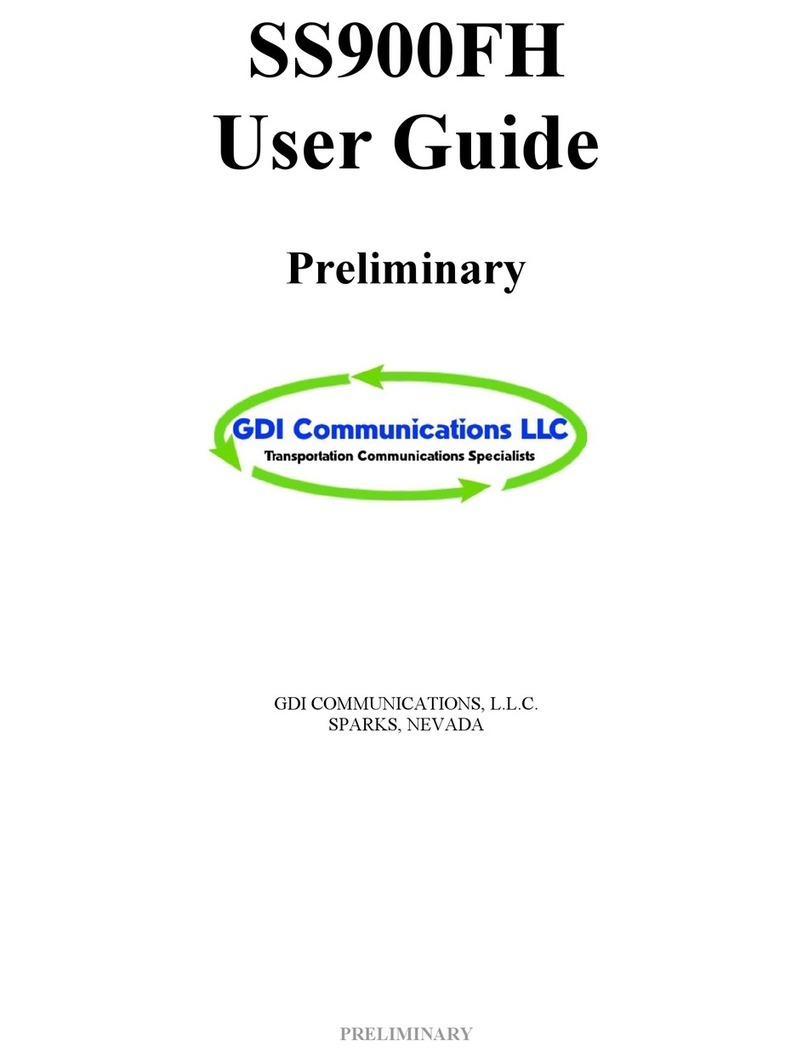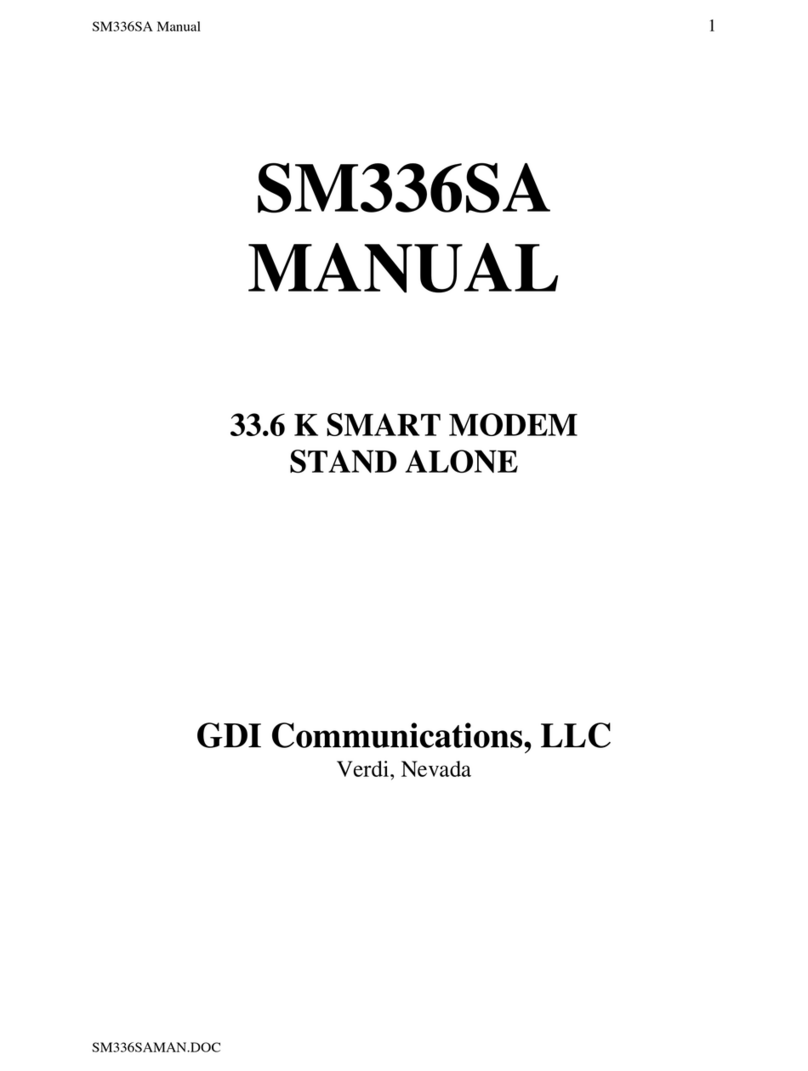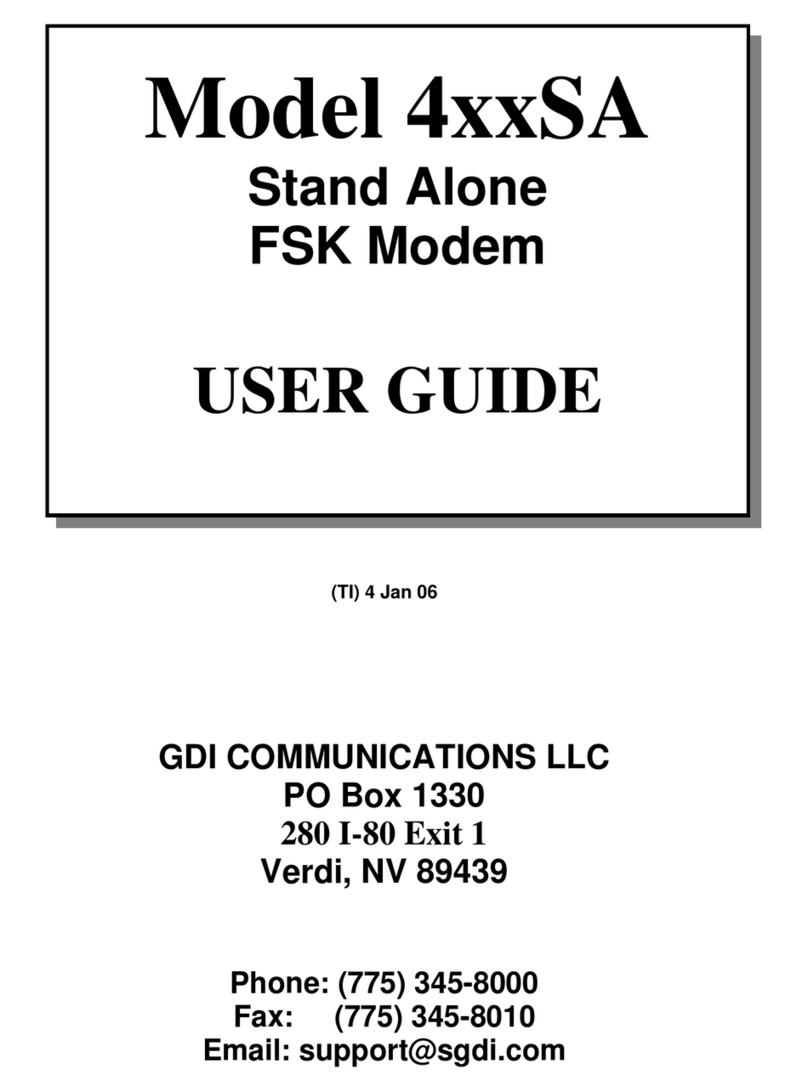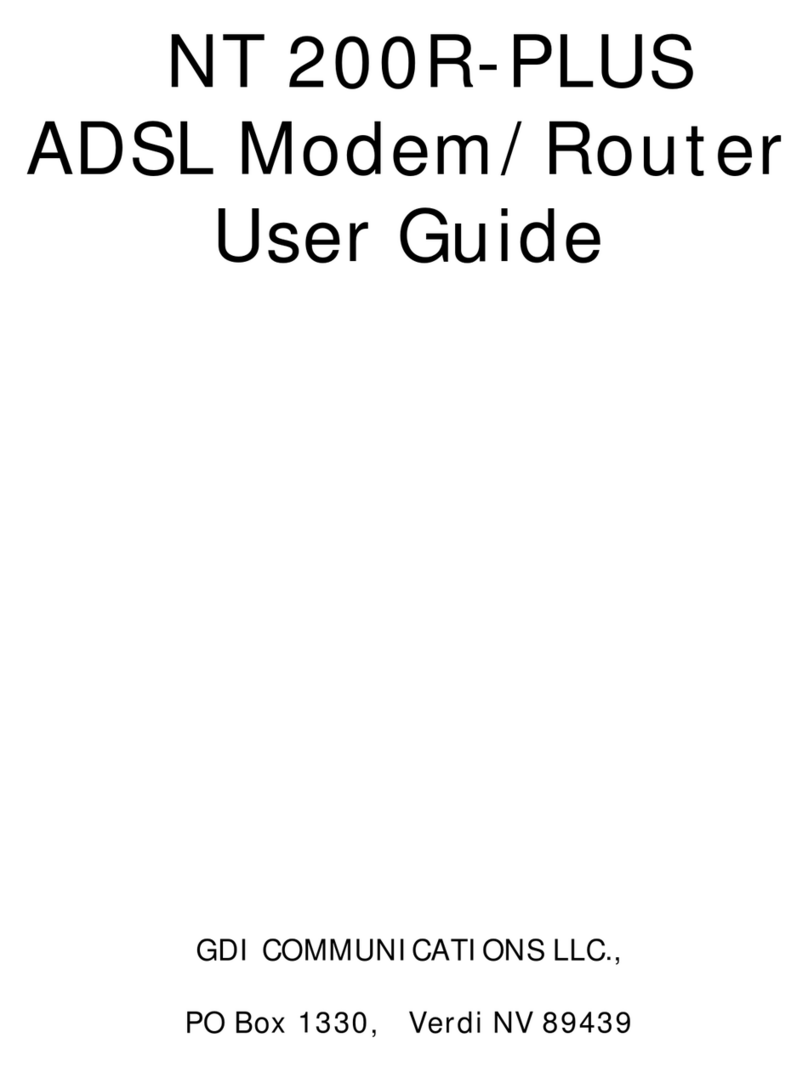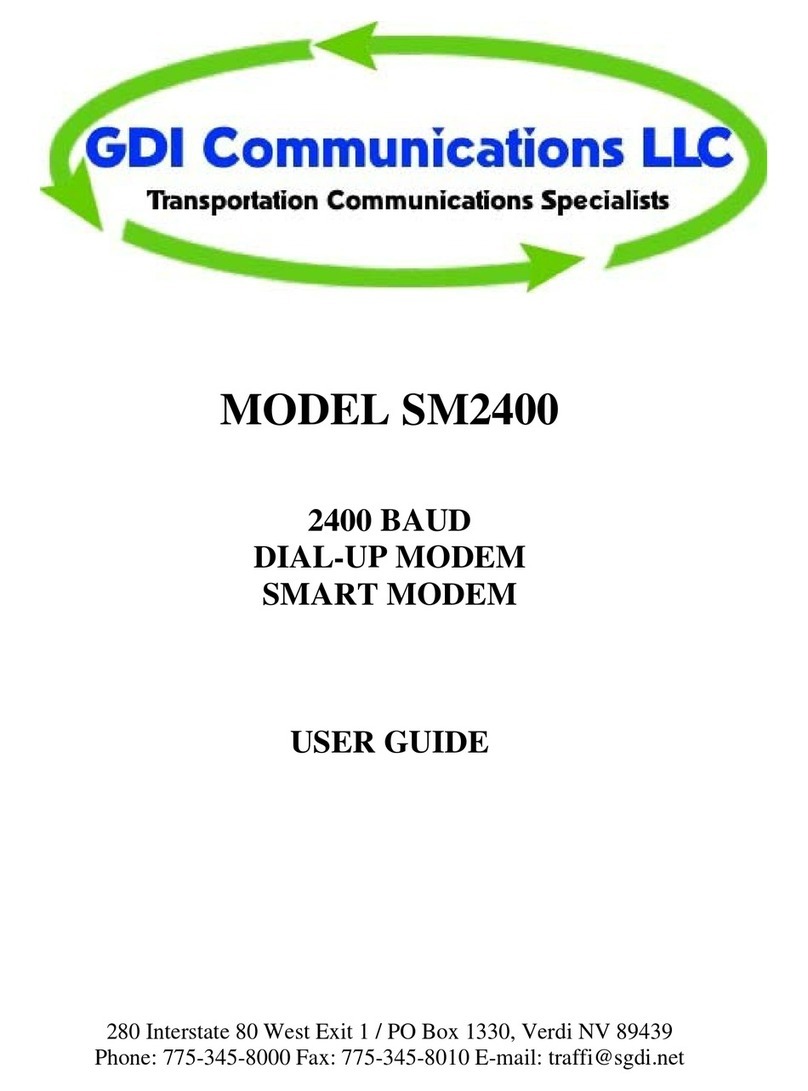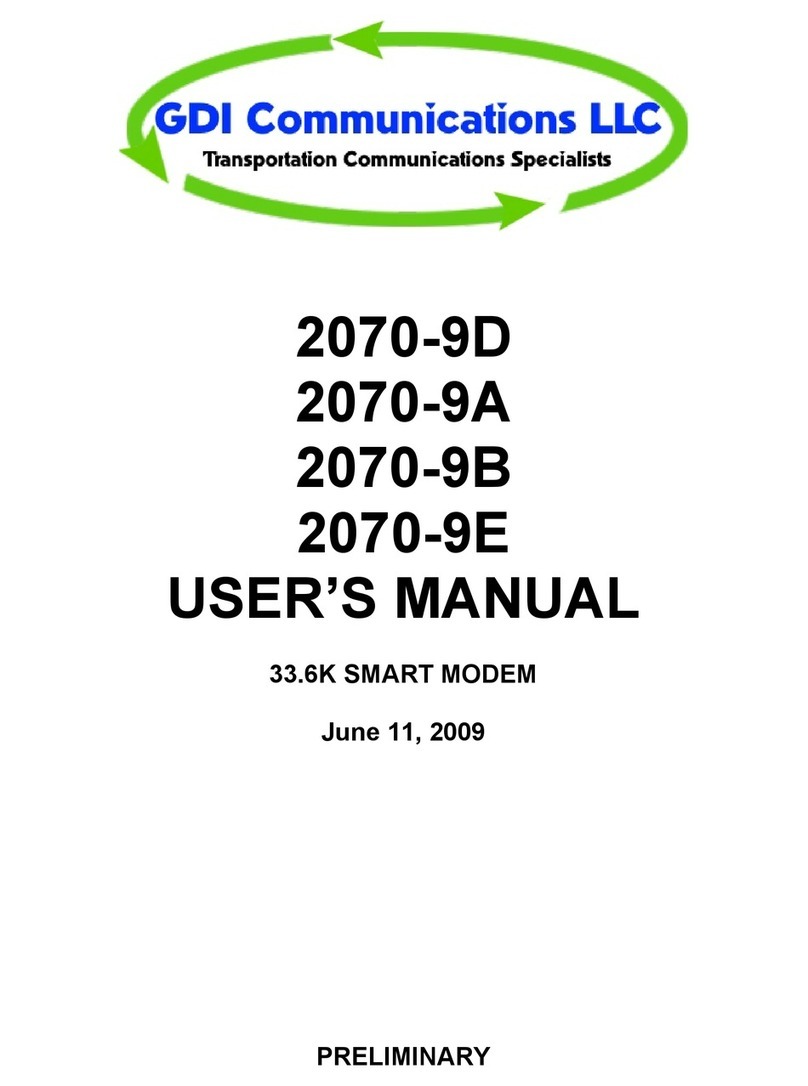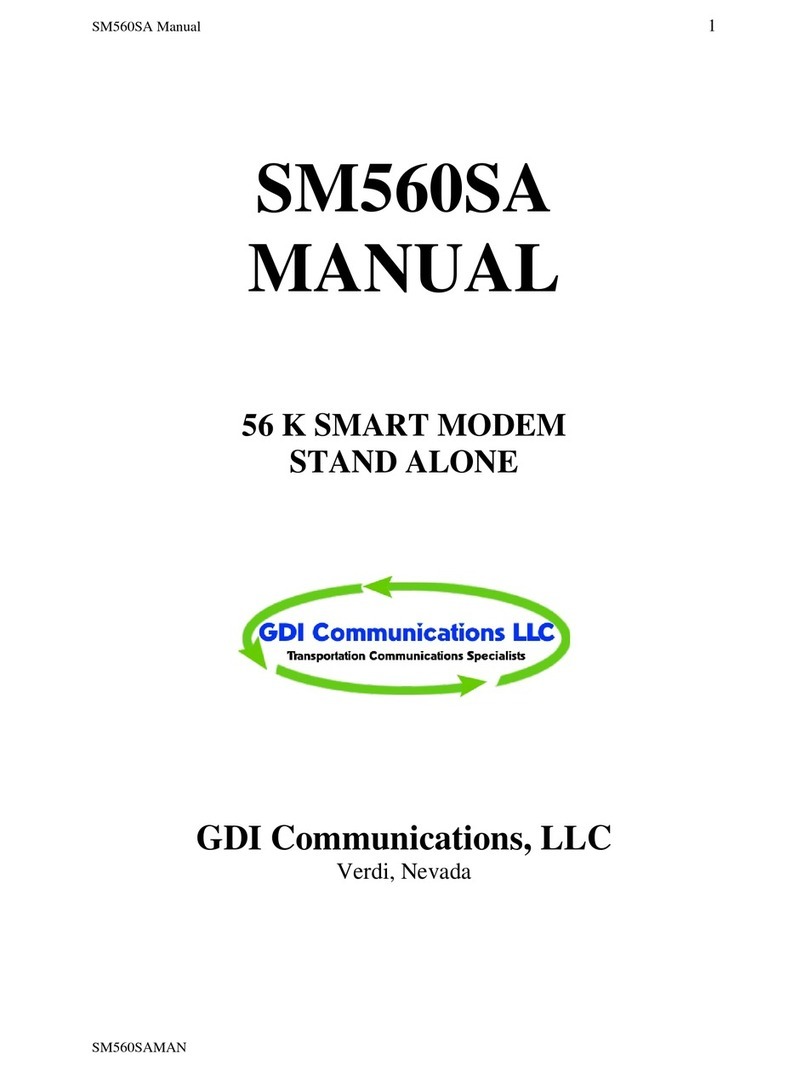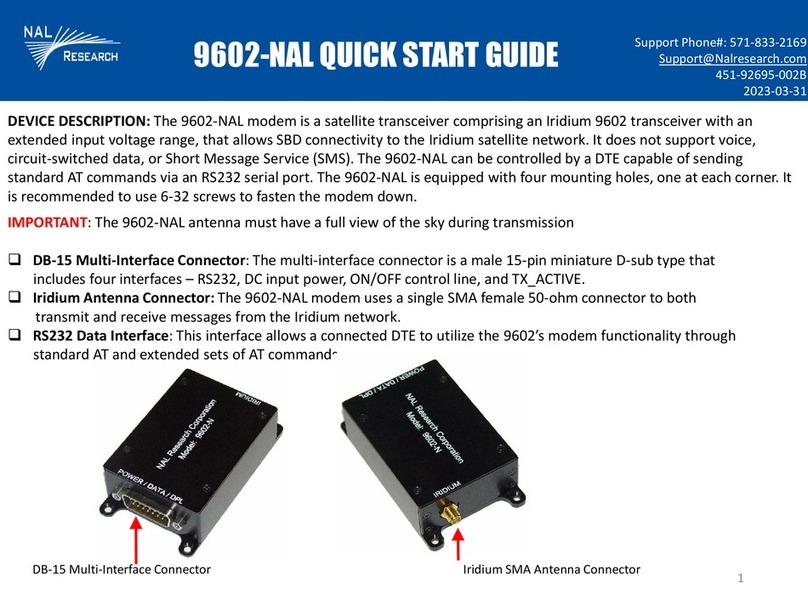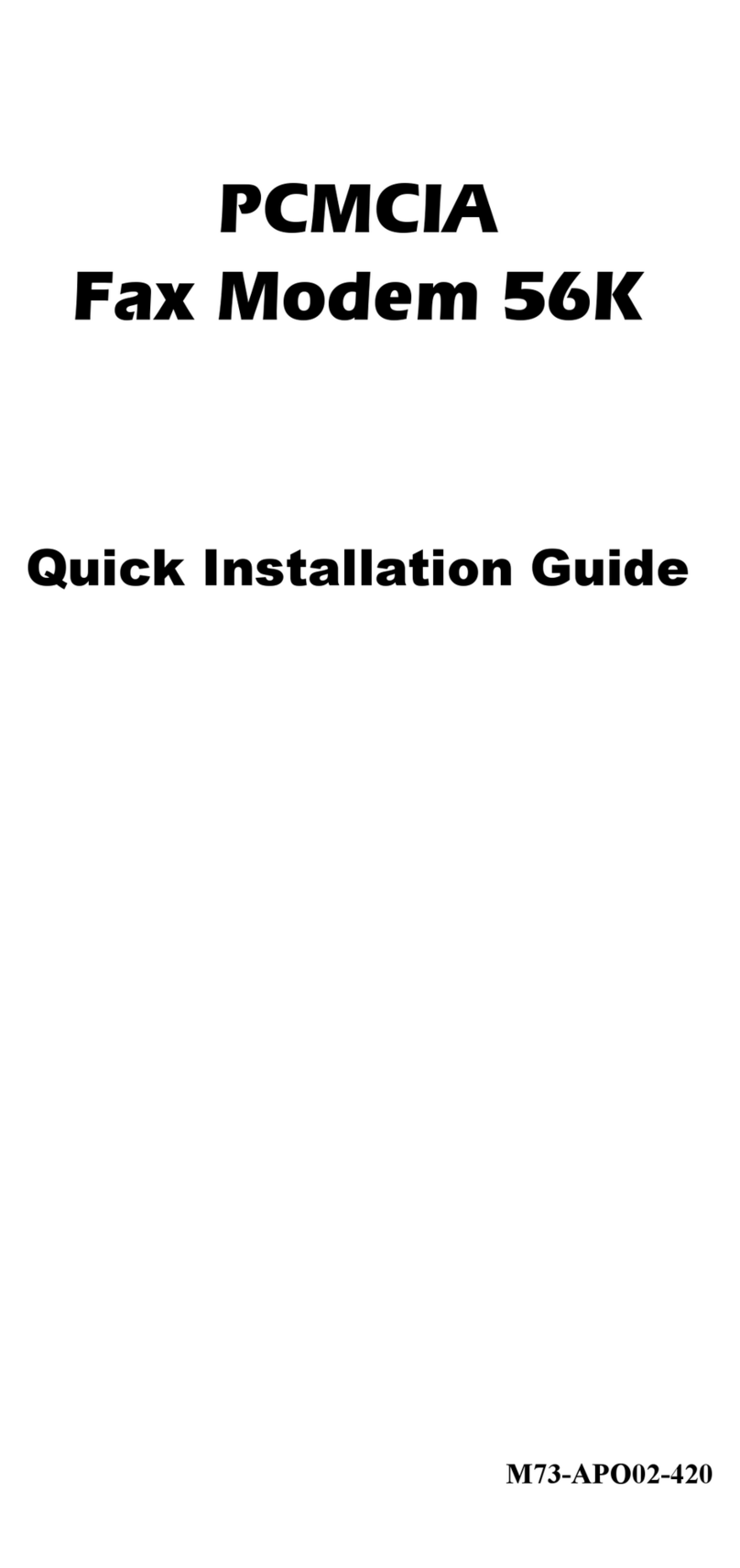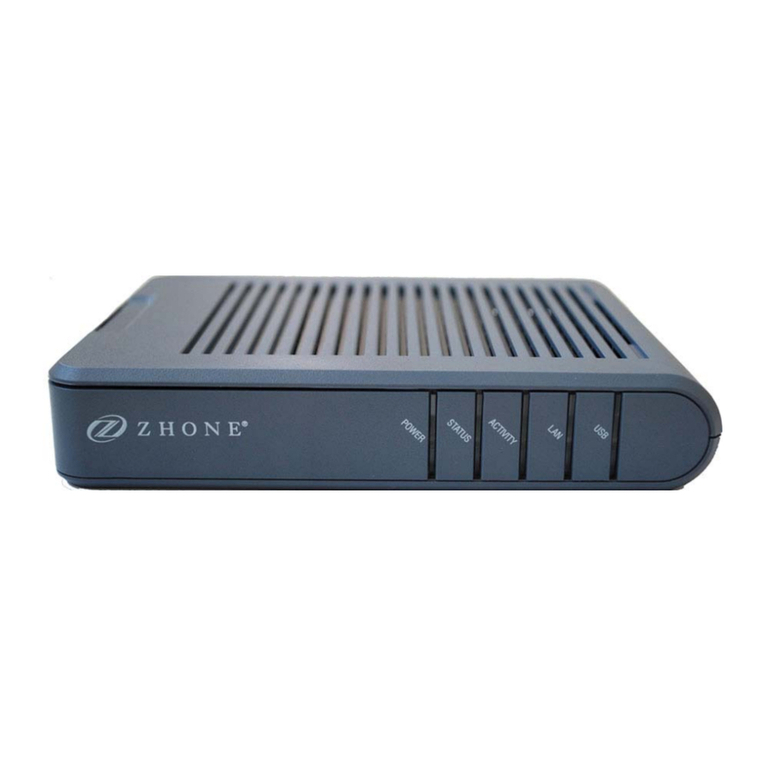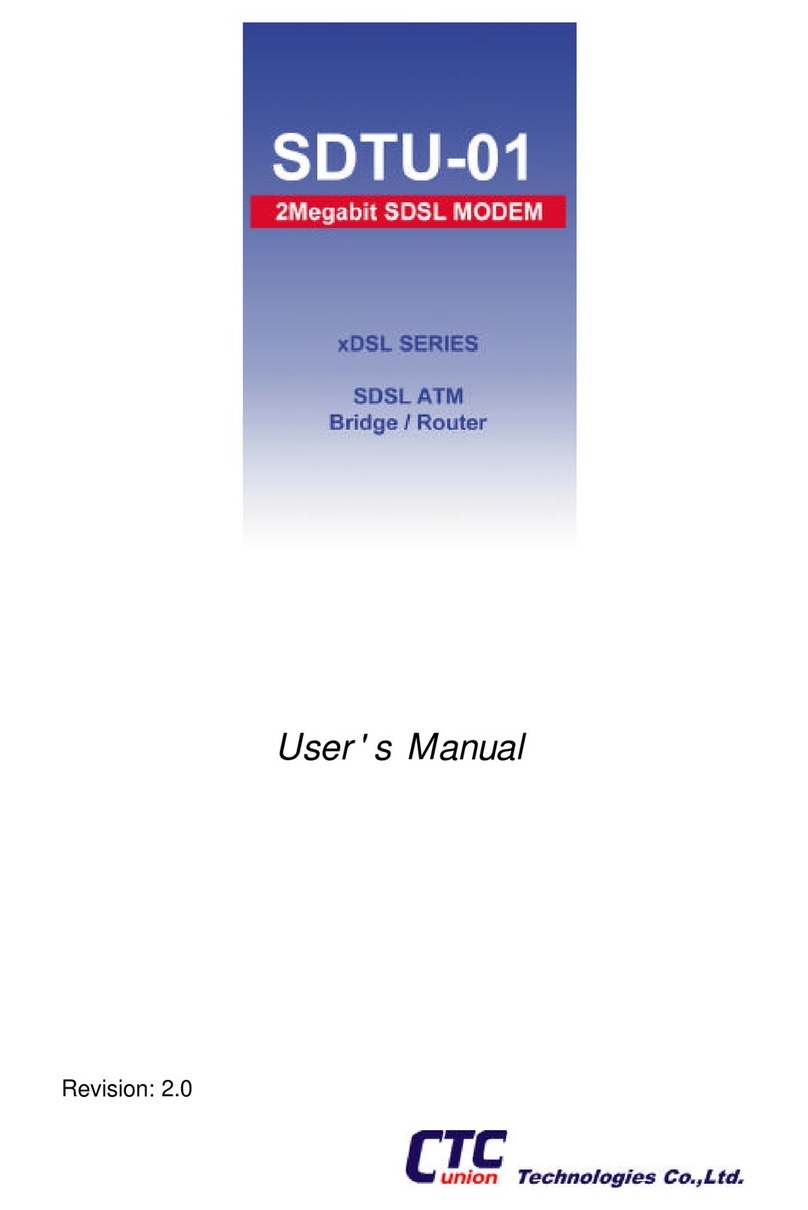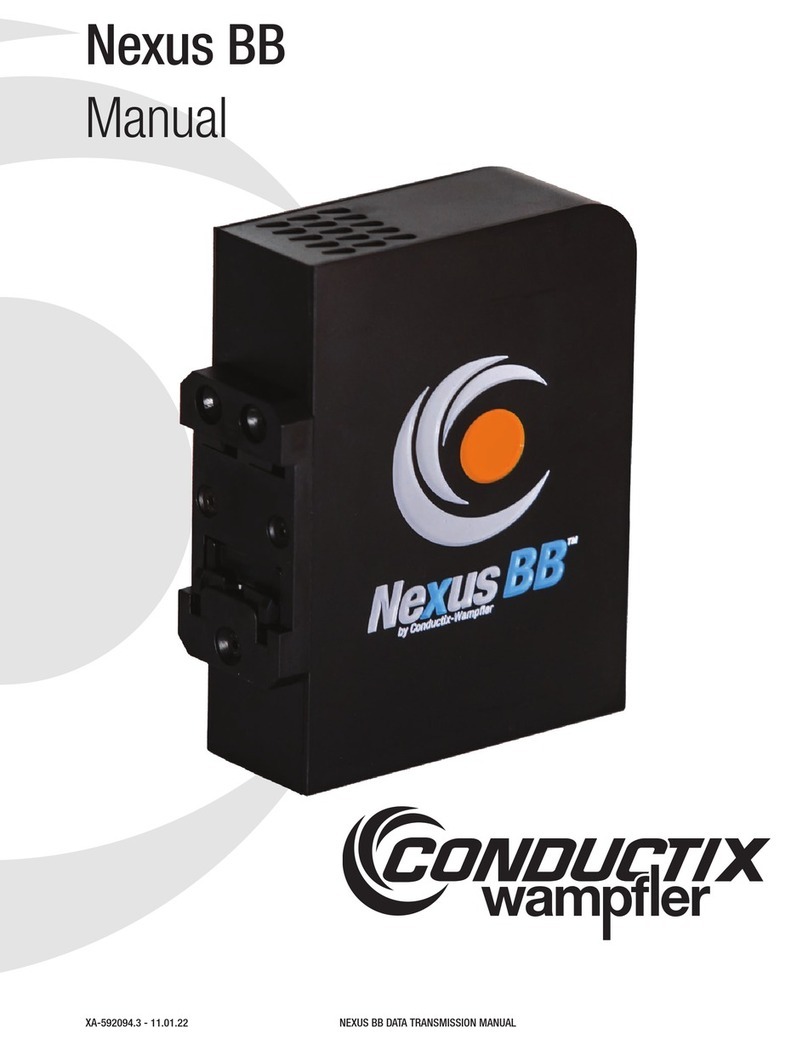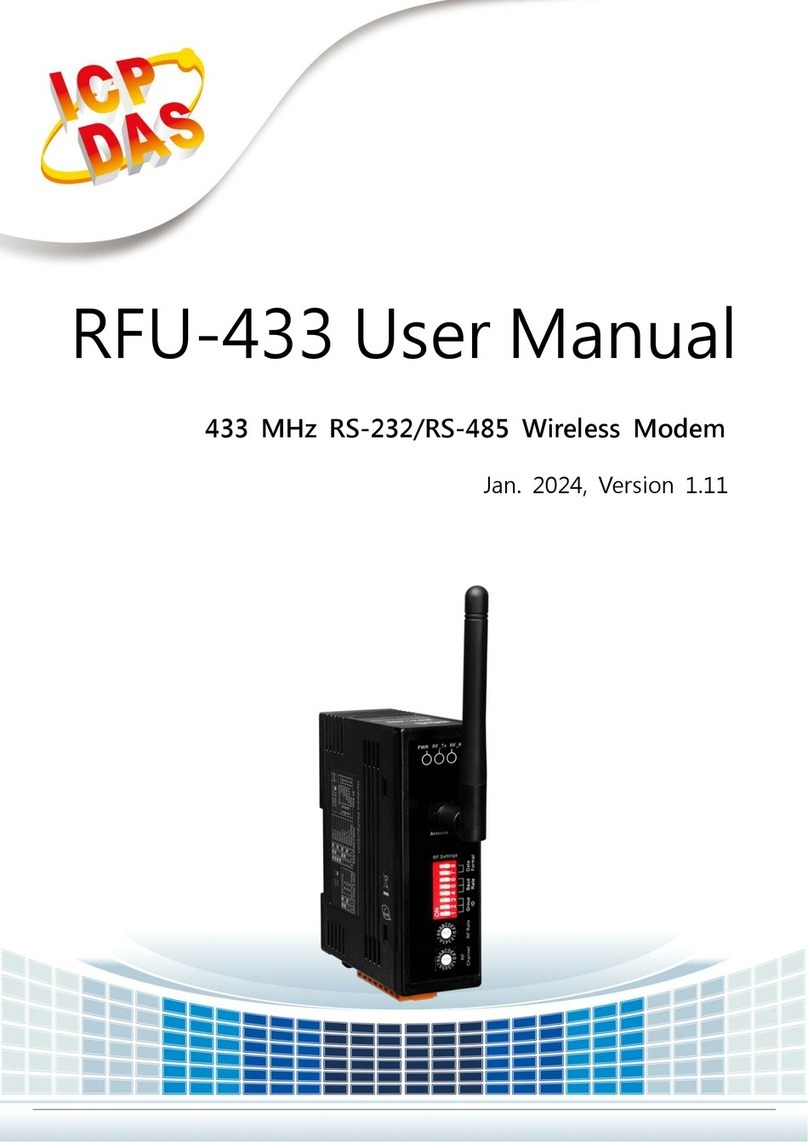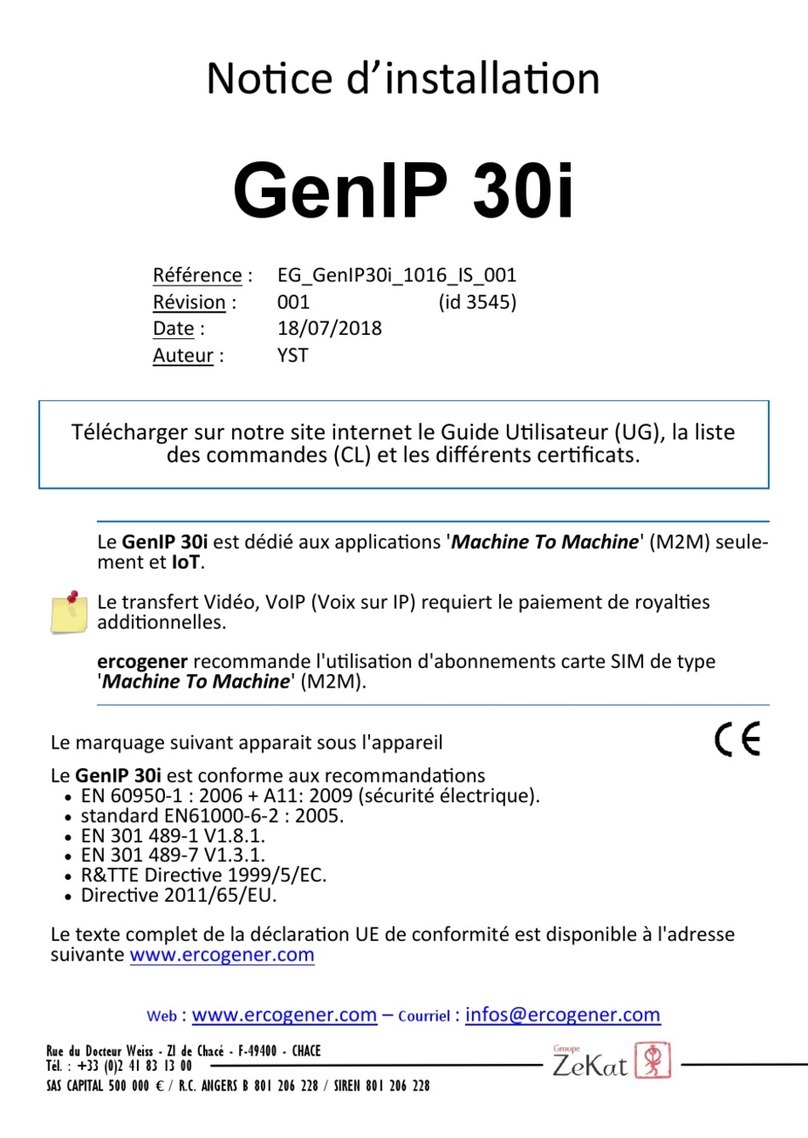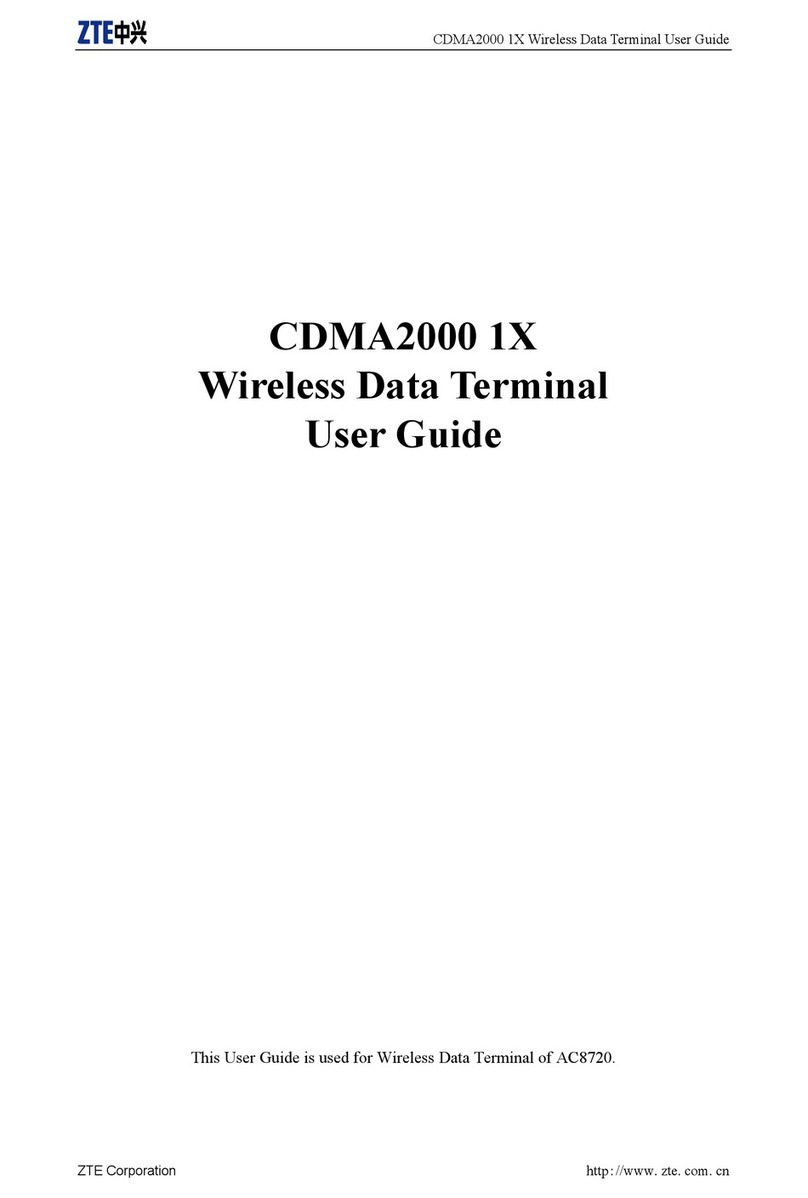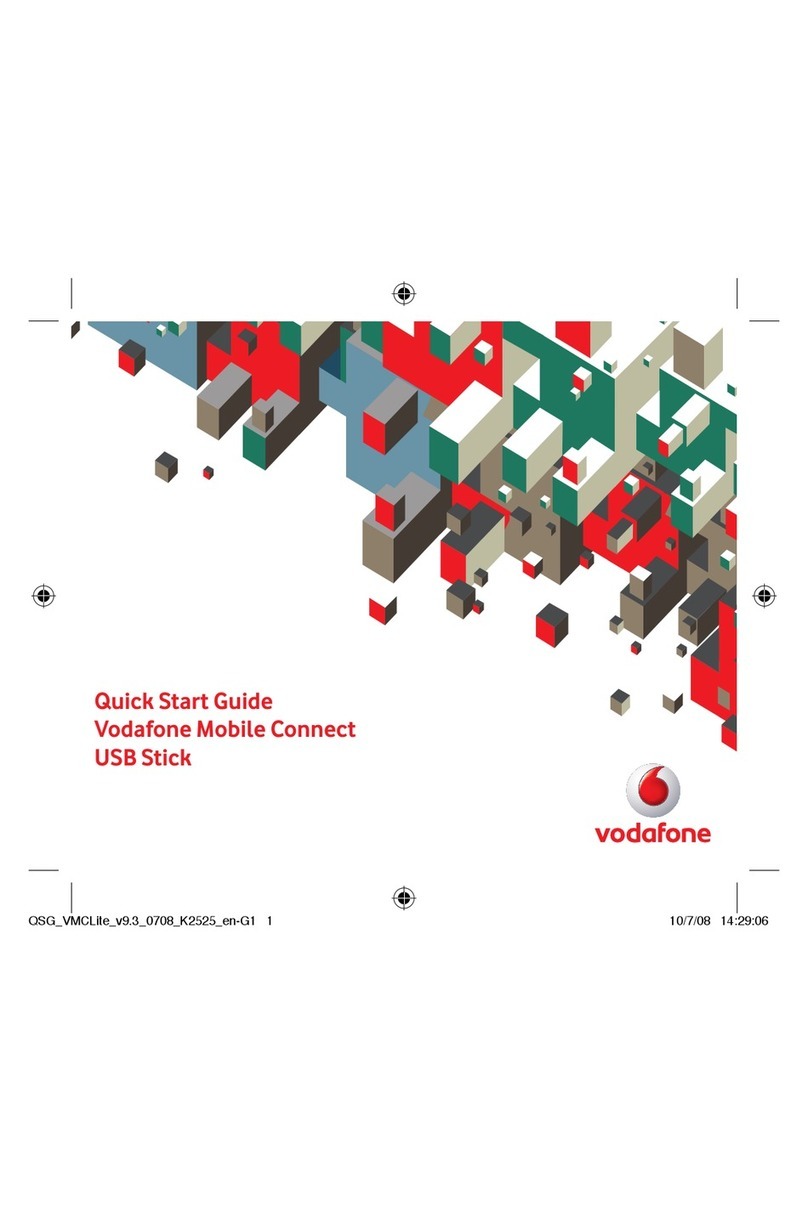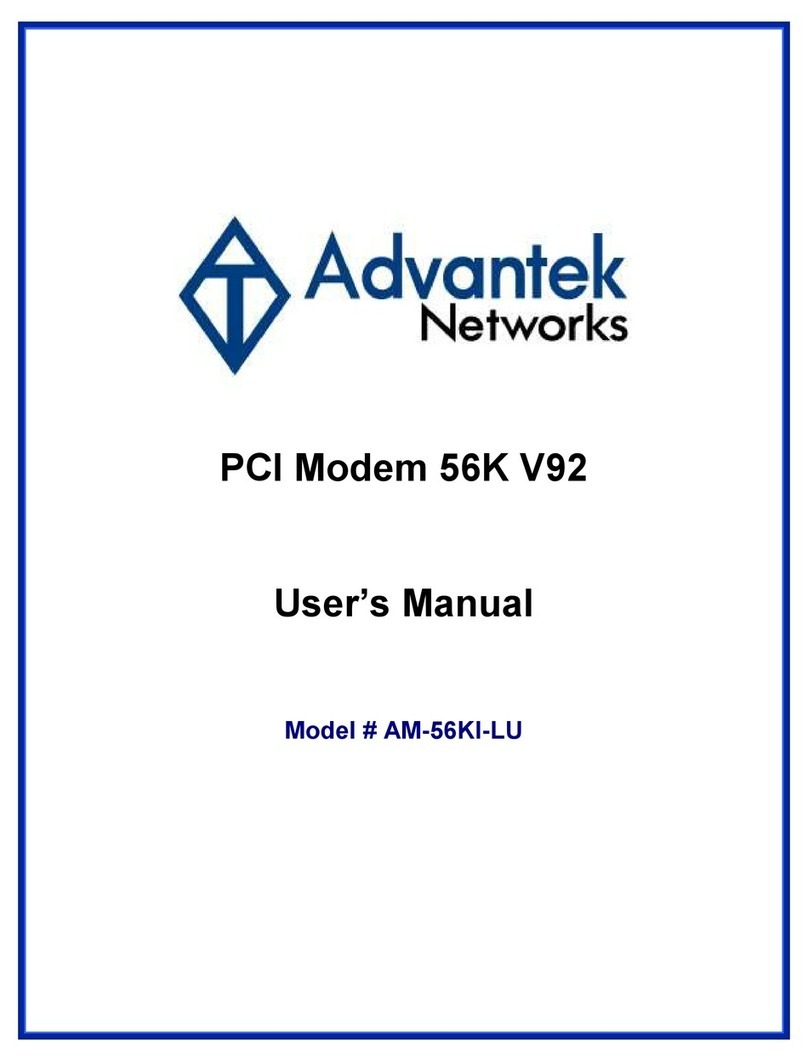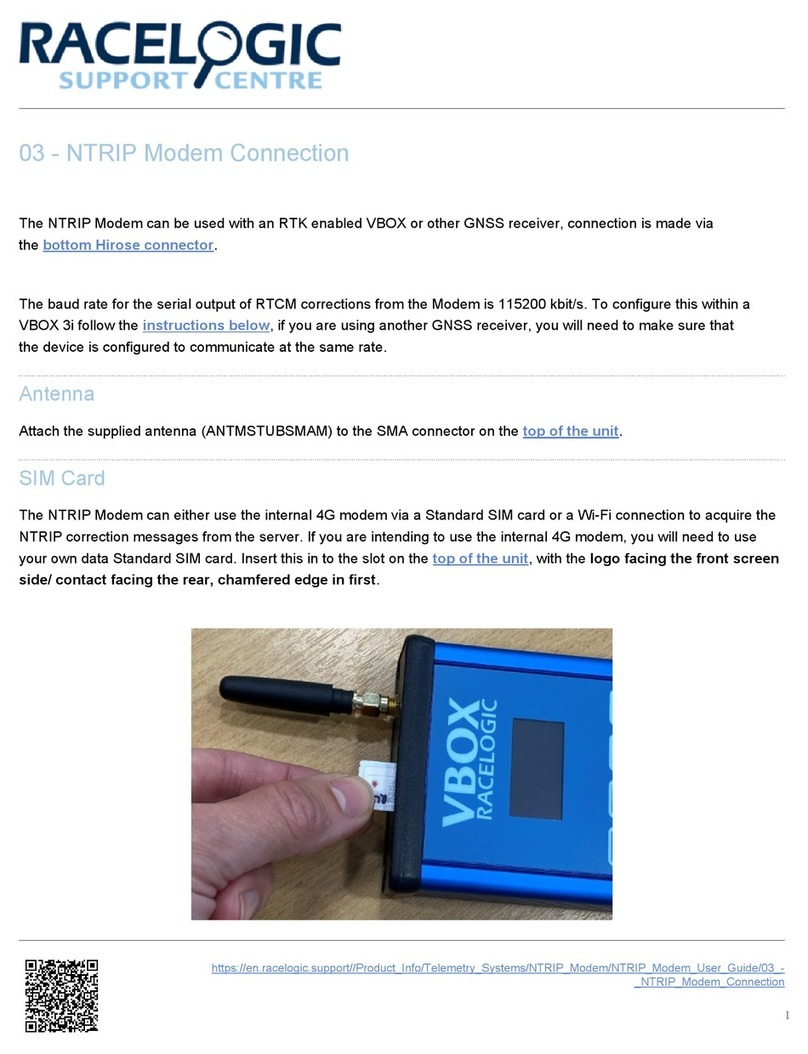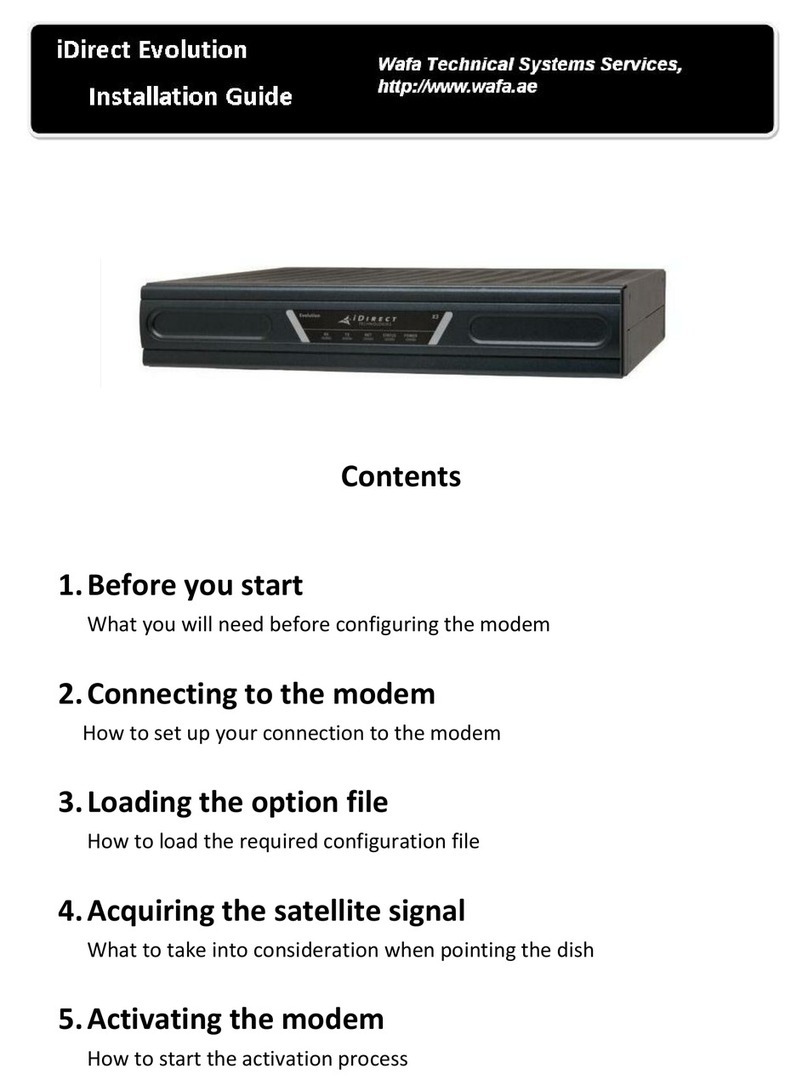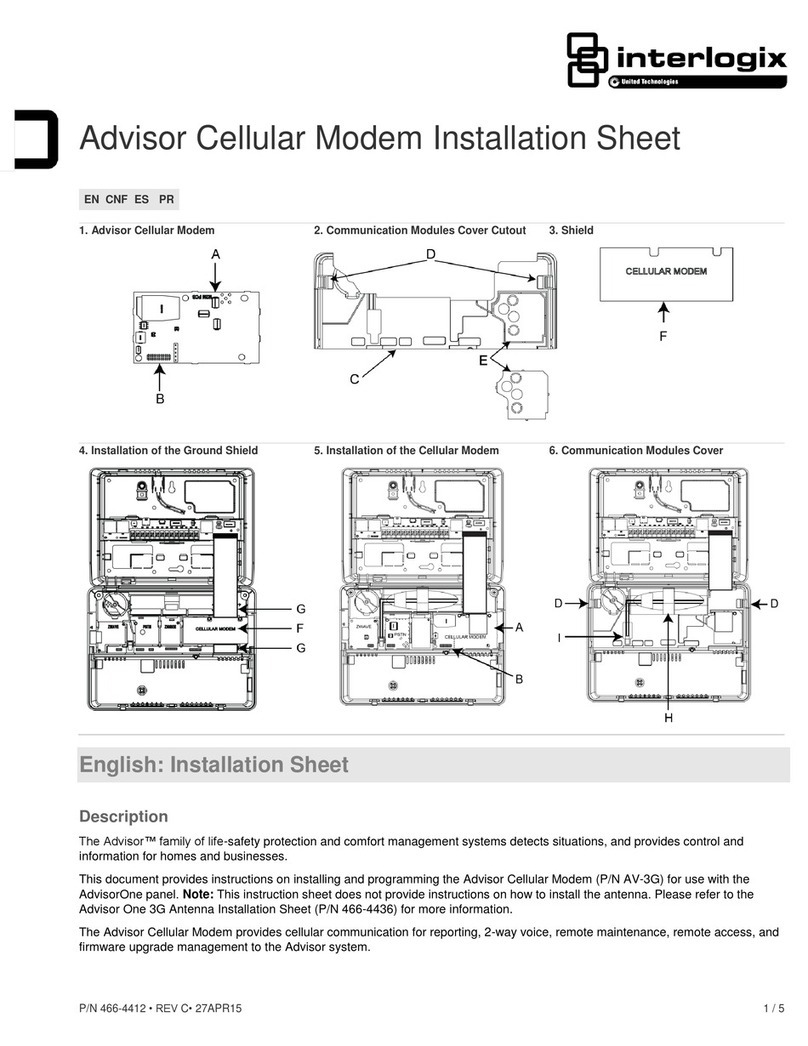GDI FDM-FSK User manual

16 Aug 06 FDM-FSK Preliminary User Guide Dwg: A01230
(TI) 16 August 2006
GDI COMMUNICATIONS LLC
PO Box 1330
280 I-80 Exit 1
Verdi, NV 89439
Phone: (775) 345-8000
Fax: (775) 345-8010
FDM-FSK
Fiber Optic Modem
With
Built in Model 4xx Series
FSK Modem
USER GUIDE
FDM Series
All Fiber Topologies - Compliant

16 Aug 06 FDM-FSK Preliminary User Guide Dwg: A01230
FDM Series of Fiber Optic Modems
•Multiple Fiber Topologies in One Modem
Single Ring, Dual Redundant Rings, Daisy Chain and Point to Point.
•Combination Fiber Optic and FSK Modems
Built in FSK Modems for 2/4 wire Copper and Fiber Applications.
•Intuitive Fiber Status Display
Pictorially indicates the switching status of the modem.
•Fiber Identification
Display shows a 1 or 2 to indicate which port the fiber belongs.
•Generates DTE Handshaking
Necessary for Remote Fiber to 2/4Wire FSK to TMC applications.
•Auxiliary Data Port
For 2/4Wire FSK or SS Radio Branch Circuits.
•Built-in Uninterruptible Power Supply
Provides Optical Continuity at a Failed Intersection.
AUX
PORT
RJ45
1 RI
3 DTR
2 CD
4 SG
RXD 5
TXD 6
CTS 7
RTS 8
MODEL FDM170
GDI Communications LLC
Verdi NV 89439
775-345-8000
INOUT
R1T2T1
R2
MODEM
FIBER STATUS
PWR
FAIL
1 8
ENABLE
DISABLE
BATTERY
AUX CONN
FDM2SA
GDI Communications
TXD
RXD
Data Ports
KOD RTS
Anti-Strm
Reset
T1
R2
R1
T2
LOS
LOS
Main
DC Power Center
Battery
Alarm Charging
RING 2
RING 1
R1
R2T2
T1
LOS
LOS
PWR
RING STATUS
MAIN DATA ALARM
RESET
ANTI-
STREAM
AUX DATA
SERIAL
PORT
TXD RXD
TXD RXD
TXD RXD
FDM
2070-6D
GDI
NEVADA
Fail
R2
T1
T2
R1
FDM2SA
FDM170
FDM2070
FDM-FiberHub
R1 T2
GDI Communications
TXD
RXD
Link Activity
Data Port Anti- Streaming
TXD
RXD
Alarm Reset
AB CD
D
T1
R2
R1
T2
T1 R2
AB
CLOS
LOS
LOS
LOS
Main
DC Power Center
Battery
Alarm Charging
FDM-FiberHub
FDM-FSK
GDI Communications
TXD
RXD
Data Ports
KOD RTS
Anti-Strm
Reset
T1
R2
R1
T2
LOS
LOS
Main
DC Power Center
Battery
Alarm Charging
CD
RTS
2/4 Wire FSK
KOD
CTS
TXD RXD
AB
FDM-FSK
Stand Alone Models Plug-in Models for Controllers and Racks

16 August 06 FDM-FSK Preliminary User Guide 1 Dwg: A01230
FDM -FSK ----- Table of Contents------ Page 1/3
FDM Series Overview 4
TheFDMSeries 4
FDM170 5
FDM2070 5
FDM-FiberHub 6
FDM2SA 6
Introduction to the FDM-FSK Modem 7
FDM-FSK
Basic Signal Flow Diagram 7
FSKModemSection 7
Modem Ergonomics 8
Front Panel 8
Fiber Optic Modem Displays 9
Data Port Activity Display 9
TXDLED 9
RXDLED 9
Data Port Anti- Streaming 9
ResetSwitch 9
Intuitive Fiber Status Displays 9
Fiber Identification 9
Fiber Status Displays for Redundant Rings and Daisy Chains 10
Fiber Status Displays for Single Rings 10
2/4 Wire LED Displays 11
CD CarrierDetect 11
KOD Key On Data 11
RTS Request To Send 11
CTS Clear To Send 11
TXDTransmitData 11
RXD Receive Data 11
DC Power Center Display 11
DC Power Center LED Indicators 12
Main 12
Charging 12
Battery 12
Alarm 12

16 August 06 FDM-FSK Preliminary User Guide 2 Dwg: A01230
Rear Panel 12
PowerConnections 12
DualDataPorts 13
OpticalPorts 13
Bottom Panel 13
Signal Flow Diagrams 14
Sequence of Events 14
Data Port Flow Diagrams 15
Setting up the Modem 16
Mounting Options 16
Configuring the FDM Modem Section 16
FDM DIP Switches 17
Master/Salve 17
Topology Selections 17
2 Rings (Self Healing Dual Counter Rotating Rings). 17
1Ring 17
DaisyChain 17
Data Protocol
RS232/422 18
BaudRates 18
Parity 18
RTS/CTS Handshaking 18
CTSDelay 18
Anti-Streaming 19
Optical Dynamic Range 19
Fiber Identification Techniques 20
Fiber Applications 21
Self Healing Dual Counter Rotating Ring Operation 21
Single Ring Operation 23
Point to Point 25
Point to Point with Redundant Fiber Path 26
DaisyChainOperation 28
Dual Daisy Chain (Center Master) 30

16 August 06 FDM-FSK Preliminary User Guide 3 Dwg: A01230
Configuring the FSK Modem Section 31
Primer on Frequency Shift Keying Modems 31
Communications Sequence of Events 32
ThePole 32
The Response 33
Front, Rear and Bottom Panels 34
2/4 Wire FSK Display
CD 34
RTS 34
CTS 34
TXD 34
RXD 34
KOD 34
RearPanel 34
Copper FSK 34
Bottom Panel DIP Switches 35
Full Duplex or Half Duplex 35
RTStoCTSTime 35
CarrierTurnOffTime 35
LocalEcho 35
Receiver Squelch Time 35
CarrierDetectTime 35
LoadCompensation 35
FSK Applications 36
Half Duplex Operation (2 Wire “One Pair”) 36
Full Duplex Operation (4 Wire “2 Pairs”) 37
A Word on Dynamic Range 38
Combined FDM and FSK Applications 39
Fiber to Copper to Fiber --- Copper Bridge Application 40
Copper to Fiber to Copper --- Fiber Bridge Application 40
Fiber with Copper Branch --- Copper Tap Application 41
Factory Default Settings and Pin-Out Diagrams 42
KOD Jumper 43
Care and Handling Procedures for Optical Connectors 44
Disclaimer 47

16 August 06 FDM-FSK Preliminary User Guide 4 Dwg: A01230
FDM SERIES OVERVIEW
The FDM Series of Hardened Modems are designed for polling applications utilizing
RS232/422 Asynchronous transmission over Multimode and Singlemode Fiber
Optics. All modems in the series are communications compatible with each other,
thus allowing greater flexibility of use.
The FDM Series comprise of six Digital Modems:
1. The FDM2SA is a Stand Alone version.
2. The FDM170 is a Plug-in version for the 170 Controller
3. The FDM2070 is a Plug-in version for the 2070 Controller
4. The FDM FiberHub performs as a 1 x 3 star optical hub that ties in
optical branch circuits into the mainstream communications path.
5. The FDM-FSK is a combination of a FDM2SA and a FSK modem.
6. The FDM-SSR is a combination of a FDM2SA and a Spread Spectrum
Radio.
The modems can operate in many different topologies, even on a simple fiber ring
when there is only one fiber available, later as more fibers become available,
simply flip a switch to change to the new topology.
This unique capability of operating in multiple topologies offers the advantage of
One Modem for all Topologies.
Switch Selectable Topologies are as follows:
•Single Fiber Ring
•Dual Fiber Redundant Ring (Self Healing)
•Point to Point
•Daisy Chain Format.
The modems have a high dynamic range yet they are immune to optical over
loads, therefore no optical attenuators are required for short runs or even bench
top “back to back” testing!
Any modem can be designated as a Master or Slave, also for Auto Restoration
any modem can be designated as an Auxiliary Master.

16 August 06 FDM-FSK Preliminary User Guide 5 Dwg: A01230
FDM SERIES OVERVIEW continued
A unique and intuitive Dual Seven Segment display graphically indicates the
status of the fiber system, making diagnostics visually simple. All FDM series
modems have the unique capability of Fiber Identification; the display will flash a
1 or 2 indicating which circuit the fiber belongs to.
Other advantages include multiple use Dual Data Ports enabling branch circuit
capabilities such as an On Street Master to Local Controller (same location), or
4wire or Spread Spectrum Radio communications.
All modems have the unique capability of having their Auxiliary Port switched
from DCE to DTE mode. This feature allows the Main port to drive the Aux-Port
as well as the fiber, primarily used for Street Master communications with the
local controller or driving some other modem.
Only FDM optical modems have the unique ability to generate a Carrier Detect
both before and after data flow, this is essential when connecting to 2 Wire FSK
communications. This Dynamic CD acts like a “DTE’s RTS” and is used to
initiate handshaking to a DCE’s RTS input.
The FDM Series represents a new generation of digital fiber optic modems
utilizing a Replaceable Operating System (ROS). As requirements change, or new
features become available, a new program can be loaded so as to provide a
migration path to upgrade the existing system.
FDM170
This is a Plug-In version for the 170 Series of Controllers and the R400/R800
Rack Series. The Main Data port is connected via the card edge connector to the
170 backplane while the Aux Data Port RJ45 is front accessible for combining
external data links in the polling stream.
For rack-mounted communications at the Traffic Maintenance Center, R400/R800
Series Racks can be populated with the FDM170 to complete the communications
system.
FDM2070
This is a Plug-In version for the 2070 Series of Controllers. The Main and
Auxiliary Data ports provide the same functionality as in the FDM170, plus one
of the 2070’s spare Serial Ports SP2 or SP4 (slot dependant) is also brought out to
the front panel. For rack-mounted communications at the Traffic Maintenance
Center, R400/R800 Series Racks would be populated with the FDM170 to
complete the communications system.

16 August 06 FDM-FSK Preliminary User Guide 6 Dwg: A01230
FDM FiberHub
The FiberHub is designed to act like a hub or star that ties
four optical branch circuits together in a 1 x 3
A typically deployment would be anywhere in a fiber
arterial daisy-chain or ring at an intersection where it ties
in the “North/South” cross street optical branch circuits
into the “West/East” main arterial fiber run. As with all
FDM modems , data ports are provided for the local
controller and auxiliary communications.
FDM2SA
This is the “Stand Alone” version and has two Data Ports, one designated as the
Main Port, the other being an Auxiliary Port. The Main Data Port is used for
connection to a controller. The Auxiliary Data Port can be used for many
associated functions such as connecting to a Backup Server or for Over the Air
Restoration, or combining external data links into the polling stream.
A unique built-in Key on Data capability allows the fiber modem to act as DTE
and provide all necessary handshaking. This unique feature allows a Remote Fiber
System (Tail Circuit) to be integrated into a 4wire FSK circuit and on to city hall.
FDM-FSK
This user guide describes the FDM-FSK and its operation.
N
WE
S

16 August 06 FDM-FSK Preliminary User Guide 7 Dwg: A01230
INTRODUCTION to the FDM-FSK
FDM-FSK
The FDM-FSK is a combination of the FDM2SA
Fiber Optic Modem and GDI’s Model 4xx Series
FSK Modem, basically it is two interconnected
modems housed in the same enclosure. Two RS232
Data Ports are provided along with the 2/4 Wire
FSK Port, all three ports communicate to and from
the fiber to the originating “master source”, see
diagram below.
Basic Signal Flow Diagram
FSK Modem Section
The FSK Modem is based on the industry standard Model 4xx series of modems
which are designed for asynchronous RS232 communications over un-terminated
private wire utilizing Frequency Shift Keying techniques (tones). The modems
data port is tied into the fiber optic data stream to provide bi-directional
communications between Fiber and FSK. The FSK Modem can communicate in 2
Wire Half Duplex or 4 Wire Full Duplex at baud rates up to 19.2Kbt/s depending
on which FSK Modem is installed. The FSK modem is 100% compatible with all
GDI modems.
The FSK section allows a number of options:
•Connecting a remote copper 2/4 wire circuit into the fiber system and
back to City Hall.
•Connecting a remote fiber system into the 2/4 wire system and back to
City Hall.
•Connecting Copper to Fiber to Copper. (Fiber Bridge)
•Connecting Fiber to Copper to Fiber. (Copper Bridge)
FDM-FSK FDM
Series
FSK 2 or 4 Wire
Main Port
Aux-Port
Main Port
Aux-Port
FDM
Main Port
Fiber Optics
Aux-Port
TMC or Street Master Remote Controller
Location Remote Controller
Location
Series
FDM2SA
FDM170
FDM2070
FDM-SSR
FDM-FiberHub
Main Server
Back-up Server
Master
Fiber Trunk
Main
Port Aux-
Port
T1
R2
T2
R1
2/4Wire
Port
Fiber Trunk
RS232 RS232 2/4 Wire
FSK
Modem
FDM2SA
Fiber Optic
Modem
FDM-FSK Modem

16 August 06 FDM-FSK Preliminary User Guide 8 Dwg: A01230
Modem Ergonomics
The Front Panel displays information on the status of the FDM-FSK.
The Rear Panel is where all the connections are made to the modem and the
switch-able options are located on the Bottom Panel to minimize ingress of
foreign material in road side cabinet applications.
On the Rear Panel, there are two dual bulkhead Fiber Ports which can be easily
changed between ST, FC and SC style connectors; so can the internal mini
patchcords located between the bulkheads and the optical transceivers.
These inexpensive patchcords act like a “fusible link” and provide the
transceivers with 100% protection from being damaged by external dirty
patchcords. Replacing the patchcords can be easily done by the customer.
Two Data Ports, Main and Auxiliary are provided, the Main Data Port DB9
typically connects to the local controller while the Auxiliary RJ45 connector can
be used to bring in radio based communications into the main data stream.
The FSK Port can operate in 2 or 4 wire mode (Half/ Full Duplex) and is 100%
compatible with all GDI FSK Modems
The FDM-FSK has three mounting options, left or right wall mounting via a pair
of “Keyhole” slots on both sides, or as a Stand Alone shelf mounted unit while
still maintaining a vertical front panel view for all three options.
The FDM-FSK has an optional internal Uninterrupted Power Supply “UPS” that
maintains full modem operation without any loss of communications.
Front Panel Displays
The FDM-FSK front panel has three distinctive information
displays:
•The upper display is for the Fiber Optic Modem.
•The middle display is for 2/4 wire FSK Modem.
•The lower display is dedicated to the DC Power Center
FDM-FSK
GDI Communications
TXD
RXD
Data Ports
KOD RTS
Anti-Strm
Reset
T1
R2
R1
T2
LOS
LOS
Main
DC Power Center
Battery
Alarm Charging
CD
RTS
2/4 Wire FSK
KOD
CTS
TXD RXD
BA

16 August 06 FDM-FSK Preliminary User Guide 9 Dwg: A01230
Fiber Optic Modem Displays
Data Ports Activity Display
This section displays the activity of data through the modem.
TXD LED
This indicates data activity from the fiber to the data port.
RXD LED
This indicates data activity from the data port to the fiber.
KOD
This indicates Data from the fiber is asserting (Keying) the
FSK Modem’s RTS and the Auxiliary Port’s DCD.
Data Port Anti-Streaming Alarm LED
This indicates port data exceeded selected time out.
Reset Switch
Switch for resetting Anti-Streaming Alarm.
Intuitive Fiber Status Displays
The seven segment displays show information as to the
integrity of the fiber system, each of the red segment lines
represent the incoming or outgoing fiber data path through
the modem, while LOS indicates a loss of incoming optical
signal.
Fiber Identification
Identifying whether a fiber has Receiver 1 or Receiver 2 traffic is as simple as
plugging in and out each fiber into any receiver, the modem will flash the
message 1or 2 to denote which receiver that fiber belongs to.
See Installation Section -- Fiber Identification Techniques, page 22 for more details.
T1
R2
R1
T2 AB
LOS
LOS
R2
Display indicates patchcord belongs in R2.
T1
R2
R1
T2 AB
LOS
LOS
R1
Display indicates patchcord belongs in R1.
TXD
RXD
Data Ports
KOD RTS
Anti-Strm
Reset
T1
R2
R1
T2
LOS
LOS
AB
TXD
RXD
Data Ports
KOD RTS
Anti-Strm
Reset
T1
R2
R1
T2
LOS
LOS
AB

16 August 06 FDM-FSK Preliminary User Guide 10 Dwg: A01230
Fiber Status Displays for Redundant Rings and Daisy Chains
Fiber Status Display for Single Rings
Loss of signal on R1
Displays will Flash
Displays will Flash
T1R1
LOS
T1R1
LOS
T1R1
LOS
T1R1
LOS
T1R1
LOS
T1R1
LOS
T1R1
LOS
T1R1
LOS
T1R1
LOS
Master
Master
Master
Master
Slave 1
Slave 1 Slave 2
Slave 1 Slave 2
T1
R2
R1
T2
LOS
LOS
Redundant Ring Displays
Common Displays
Daisy Chain Displays
Loss of Signal Causes Local LOS and Fold Back to
Flash (Ring Alarm Condition).
Normal Display.
(Displays not Flashing)
T1
R2
R1
T2
LOS
LOS
T1
R2
R1
T2
T1
R2
R1
T2
T1
R2
R1
T2
Loss Of Signal
LOS LED’s Flashing
LOS
LOSS of R1 causes
R2/T2 Foldback
First Modem set
to Daisy Chain Last Modem set
to Daisy Chain
T1
R2
R1
T2
T1
R2
R1
T2
LOS
LOSS of R2 causes
R1/T2 Foldback
No LOS by default on first
modem
No Fiber No Fiber
LOS
No LOS by default on last
modem
Flashing Display indicates a
Transport Layer fault on the
Fiber System.
All Modems Flash

16 August 06 FDM-FSK Preliminary User Guide 11 Dwg: A01230
2/4 Wire FSK Display
This section displays the activity of data through the FSK Modem.
CD LED
This indicates the modem has detected a carrier tone from a
remote modem on the 2/4 Wire circuit.
KOD
This indicates Data from the fiber is asserting (Keying) the FSK Modem’s RTS.
RTS LED
This indicates the Fiber Optic modem has asserted RTS to the FSK modem.
CTS LED
This indicates the FSK modem has asserted CTS to the Fiber Optic Modem.
TXD LED
This indicates data is being transmitted from the Fiber Optic modem to the FSK
Modem.
RXD LED
This indicates data is being received from the FSK Modems 2/4 Wire circuits
DC Power Center Display
The DC Power Center shows the power state of the FiberHub.
The DC Power Center provides information on the status
of the optional internal Uninterrupted Power Supply
(UPS), such as incoming Main power, battery Charging
(full and trickle charge), Alarm (no external power) and
Battery power only.
If the modem is equipped with an optional internal UPS
and power fails, the supported modem(s) will be fully
operational until the batteries are depleted. Resumption of
power will start the battery charging process while at the
same time the modem will be fully operational.
If the installation site supports a 24VDC UPS this may be
connected to the DC power connector on the modem in
lieu of an internal UPS.
Main
DC Power Center
Battery
Alarm Charging
Normal Condition
Running on Main Power and
charging the batteries
Main
DC Power Center
Battery
Alarm Charging
Incoming Power Failure
Running on Battery Power with
an Alarm indication.
CD
RTS
2/4 Wire FSK
KOD
CTS
TXD RXD

16 August 06 FDM-FSK Preliminary User Guide 12 Dwg: A01230
DC Power Center LED Indicators
Main
Indicates the modem is running of external power and is
paired with the Charging LED.
Charging
The LED has two indicating modes,
1. On Solid, this indicates the battery is being charged at the maximum
rate.
2. Pulsing indicates the battery has reached a full
charge state and is being maintained. Pulse duty
cycle varies with the state of charge.
Battery
Indicates the modem is running on batteries only and is paired with the Alarm
LED.
Alarm
Indicates external power has failed.
Rear Panel
The rear panel is where the Fiber Optic, Data, FSK
2/4Wire and Power connections interface to the modem,
note that the fiber connections logically match the front
panel fiber displays. The FSK connection diagram
illustrates how to correctly connect 2 or 4 wire copper
applications.
Power Connections
The modem can be connected to an external 24VDC UPS
via the DC Jack, also a battery disconnect switch is
provided for shipping or storage purposes.
Battery
Enable
Disable
18-30VDC
Main
DC Power Center
Battery
Alarm Charging
Main
DC Power Center
Battery
Alarm Charging
Main
DC Power Center
Battery
Alarm Charging
T2
R1
R2
T1
18-30VDC Battery
Enable
Disable
1 8
Main
Aux
Ports
18
4W FSK 2W
In Out
AB

16 August 06 FDM-FSK Preliminary User Guide 13 Dwg: A01230
Dual Data Ports (FDM)
The fiber optic modem has Dual RS232 Data Ports (Main and Auxiliary).
This is a single channel with dual ports, the main
Data Port DB9 connector goes to the local
controller while the Auxiliary RJ45 connector can
be used to bring in auxiliary or radio based
communications into the main data stream. The
Aux Data Port can be switched to operate as RS422
interface.
Optical Ports
The craft friendly layout of the optical ports
matches the Front Panel Fiber Display which
makes for ease of installation.
The designation A & B refer to Port Designations
when connecting to the FDM-FiberHub.
The optical ports are dual hybrid adapters that are
easily interchangeable should a different style of connector be required such
as ST, FC and SC.
These hybrid adapters are coupled to the main optical transceivers through
replaceable mini patchcords that isolate and protect the main optics from
damage due to external dirty or damaged patchcords.
Bottom Panel
This panel is where the FDM-FSK is set up for Fiber and FSK
Operation. Data rates on both the FDM and FSK modems must
be the same for obvious reasons.
Pin out connection diagrams are also included on this panel to
assist the technician when making interconnect cables. The
FSK Connections are shown on the rear panel.
Switch settings are described on page 17 for the FDM and page
35 for the FSK.
1 8
Main
Aux
Ports
18
T2
R1
R2
T1
A B
Slave
Off
1 Ring
Ring
RS485
Off
Off
Off
Off
Off
Off
Off
Parity None
Odd Even
RTS-CTS Off
CTS-0ms 8ms
Ant-Strm Off
2
4
8
18
32
64 Off
Aux.Port DCE DTE
Master
Aux. Master
2 Rings
Daisy Chain
RS232
1200
2400
9600
19.2Kbts
38.4Kbts
57.6Kbts
115.2Kbts
Port Switch Assignment
Data Port Pinouts
RS-232 RJ45
Auxiliary
18
2 DCD
4 GND
5 RXD
6 TXD
7 CTS
8 RTS
NO CONNECTION
PINS 1-3
DCD
RXD
TXD
GND
CTS RTS
NO CONNECTION
PINS 4-6-9
Main
RS-232 Female
15
69
Full
Duplex
12ms 6ms
10ms 5ms
(Full) Off On (Half)
6ms 3ms
8ms 4ms
Hi 600 Ohms
Switch Actuator
Half
Duplex
RTS to CTS Time
Cxr. Turnoff Time
Local Echo
Rcr. Squelch Time
Cxr. Detect
Load Compensation

16 August 06 FDM-FSK Preliminary User Guide 14 Dwg: A01230
Signal Flow Diagrams
Sequence of Events
•The Polling Data enters the Masters Main or Auxiliary Port and is then broadcast
to the remote modems over the fiber optics.
•At each Remote FDM the Polling Data is past to the Main, Auxiliary and if
equipped, the FSK Ports.
•Response Data entering the Remotes Main, Auxiliary and FSK Ports is
transmitted back to the Master Modem.
•At the Master Modem, Response Data from the Remotes is passed to the Masters
Main and Auxiliary Ports and back to the Servers.
FDM-FSK FDM
Series
FSK 2 or 4 Wire
Main Port
Aux-Port
Main Port
Aux-Port
FDM
Main Port
Fiber Optics
Aux-Port
TMC or Street Master Remote Controller
Location Remote Controller
Location
Series
FDM2SA
FDM170
FDM2070
FDM-SSR
FDM-FiberHub
Main Server
Back-up Server

16 August 06 FDM-FSK Preliminary User Guide 15 Dwg: A01230
Data Port Flow Diagrams
1. Normal Operation at a Controller Location.
(Aux Port switched to Normal Mode DCE)
This dual ports allows the Main Port to be connected to Local Controller,
while the Auxiliary Port can be connected to another modem such as a Spread
Spectrum Radio (DCE), while the FSK port drives the 2 or 4Wire system.
Mounting Options
The modem has several versatile mounting options, it
can be shelf mounted as a Stand Alone, or hang on a
cabinet wall utilizing a pair of “Keyhole” slots.
Both sides have pairs of keyhole slots for left or right
wall mounting so as to maintain the desired front or
rear panel view, hole centers are at 7.5inches.
DTEAux.Port DCE
AB Fiber
Lines Data Flow
3 TXD
6 TXD
2 RXD
5 RXD
7 RTS
8 RTS
8 CTS
7 CTS
Main Port (DB9F)
Aux Port (RJ45)
Local
Controller
(DTE)
Spread
Spectrum
Radio
IFC-AXXXXX
IFC-AXXXXX
Common
Function
FDM-FSK DCE Operation
Data Ports
Fiber Optics
FDM
1 DCD
2 KOD
RTS
+ 5V
In
Out
FSK
Data Flow
KOD
RTS (DCD)
2W
4Wire
FDM Data Ports
FSK Audio
To Master via
Fiber Optics
FSK
Remote
Modems

16 August 06 FDM-FSK Preliminary User Guide 16 Dwg: A01230
Setting up the Modem
Configuring the FDM-FSK Modem
You must configure the modem to your system
requirements by using the DIP Switches located on the
bottom of the modem. Basically you will be selecting:
FDM (Optical Modem)
•Master or Slave
•Aux-Master
•Fiber Topology
•RS232 or RS485
•Baud Rate
•Parity – None, Odd or Even
•RTS On or Off
•RTS Delay
•Anti Streaming On or Off
•Anti-Streaming Delay Times
•Aux-Port DCE or DTE
FSK Modem
•Full or Half Duplex
•RTS to CTS Delay
•Carrier Turn Off Time
•Local Echo
•Receiver Squelch Time
•Carrier Detect
•Load Compensation
It is suggested that you first configure the FDM Modem and then configure the
FSK Modem.
Slave
Off
1 Ring
Ring
RS485
Off
Off
Off
Off
Off
Off
Off
Parity None
Odd Even
RTS-CTS Off
CTS-0ms 8ms
Ant-Strm Off
2
4
8
18
32
64 Off
Aux.Port DCE DTE
Master
Aux. Master
2 Rings
Daisy Chain
RS232
1200
2400
9600
19.2Kbts
38.4Kbts
57.6Kbts
115.2Kbts
Port Switch Assignment
Data Port Pinouts
RS-232 RJ45
Auxiliary
18
2 DCD
4 GND
5 RXD
6 TXD
7 CTS
8 RTS
NO CONNECTION
PINS 1-3
DCD
RXD
TXD
GND
CTS RTS
NO CONNECTION
PINS 4-6-9
Main
RS-232 Female
15
69
Full
Duplex
12ms 6ms
10ms 5ms
(Full) Off On (Half)
6ms 3ms
8ms 4ms
Hi 600 Ohms
Switch Actuator
Half
Duplex
RTS to CTS Time
Cxr. Turnoff Time
Local Echo
Rcr. Squelch Time
Cxr. Detect
Load Compensation

16 August 06 FDM-FSK Preliminary User Guide 17 Dwg: A01230
Configuring the FDM Modem Section
FDM DIP Switches
Master/Slave.
The modem at the “Head End” or “TMC” that connects into the
fiber system defines that it will be set as a Master, all other
modems shall beset as slaves.
Auxiliary Master Selection
This switch selection is used for Alternate TMC Disaster Recovery scenarios.
Typically a city works yard would have an Emergency TMC,
it is here that the local modem would be set as an Auxiliary
Master. Should a failure occur at the Primary Master
location, the Auxiliary Master will automatically take over
the operation of the fiber system, then automatically hand
back control when the Primary TMC is back on line.
Topology Selections
Please note that you can have any combination of the following topologies,
just mix or match, see Fiber Applications on page 21 for examples.
1. 2 Rings (Self Healing Dual Counter Rotating Rings)
This selection provides the best fault tolerant protection.
2. 1 Ring
This selection is used when there is only one spare fiber
left to form a Single Ring
3. Daisy Chain
This selection is for the classic Daisy Chain, leave the
previous switch set to 2 Rings.
1 Ring2 Rings
1 Ring
Ring
2 Rings
Daisy Chain
Slave
Master
Off
Aux. Master

16 August 06 FDM-FSK Preliminary User Guide 18 Dwg: A01230
Data Protocol
RS232/422
Select RS232 when connecting to traffic controller or other
devices utilizing a RS232 port.
RS422 is used to drive longer distances than RS232 over 2
pairs of balanced transmission lines .
Baud Rates
The selectable Baud Rates are, 1200, 2400, 9600, 19.2Kbt/s,
38.4Kbt/s, 57.6Kbt/s and 115.2Kbt/s.
Parity
Parity can be set for None, Odd or Even.
Switch settings shown are Parity enabled and Even selected.
For no Parity select None.
RTS/CTS Handshaking
When Handshaking is turned Off, data arriving at either data
port from the attached devices will be transmitted over the
fiber.
When Handshaking is turned On and RTS is high or raised,
data arriving at either data port from the attached devices will
be transmitted over the fiber. When RTS is low no data will
flow
CTS Delay
The RTS to CTS delay can be set at 0ms or 8ms, 0ms is for
fast operation and 8 ms is used for external transmission
systems that require a delay.
Off
Off
Off
Off
Off
Off
Off
2400
9600
38.4Kbts
57.6Kbts
1200
19.2Kbts
115.2Kbts
Parity None
Odd Even
RTS-CTS Off
CTS-0ms 8ms
RS422RS232
Table of contents
Other GDI Modem manuals
